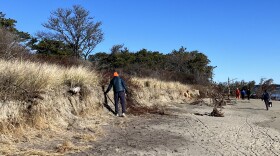An insect that hadn’t been seen in Connecticut for a century has been popping up again. It’s called the black-and-gold bumblebee.
Bombus Auricomus — that’s their scientific name — like wide-open spaces like prairies and grasslands. Tracy Zarrillo of the Connecticut Agricultural Experiment Station said you can spot them by their distinctive color pattern on their midsection.
“A black band of hairs that run from wing to wing. The first segment of the abdomen is also black — most of our more common bumblebees that we see in Connecticut have the first segment of their abdomen yellow,” Zarrillo said.
The bumblebee was spotted in Connecticut in 1919 — and it was rare even then.
“And then we haven’t seen it since then until now,” Zarrillo said.
It’s not endangered, but scientists think a regrowth of forests 100 years ago led the species to seek out more open meadows and fields. Zarillo said it’s popped up in Connecticut three times this year, and there have been a few sightings in New York, as well.
“So I talked to several of my colleagues to find out why this bee is showing up,” Zarillo said.
Zarillo said it could just be the regular ebb and flow of species population — or it could be an influx of people paying attention.
“There are more people out there watching bumblebees, planting flowers for them and taking pictures of them and uploading them to places like iNaturalist and Bug Guide,” Zarillo said.
Those are apps specifically for amateur naturalists to document the cool animals and plants they see. So it could be the black-and-gold bumblebee’s been back for a while — and people are only now noticing.
Copyright 2021 WSHU. To see more, visit WSHU. 9(MDExNDI3NjUzMDEzNjkzMTgzNTExNDFlYQ004))




